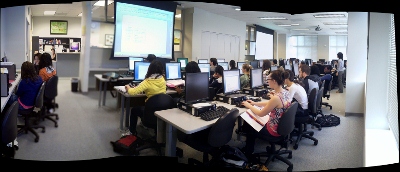Archive
Virtual Whiteboard in Computerized Classrooms
To virtualize/digitize your classroom scripts/textbooks/etc. – with all the obvious benefits (single familiar, control interface for multimedia, audio and video) and hidden benefits, like being able to link to offline (e.g. MS–Proofing Tools, MS-Text-to-Speech API) and online language learning tool (e.g. dictionaries, image libraries), use the already installed and supported hardware and software tools in computerized classrooms.
Hardware:
- Teacher Computer
- LCD Projector
- LCD Projector Screen
- Classroom Speakers
- Wireless keyboard/mouse
Software/Content:
- Textbook Scans as images – common nuisance: as ingle exercise (or a rule explanation and its practice exercise) gets spread over 2 pages that won’t fit on document camera –> right-click, open with, “Paint”, use rectangle selection, edit/cut, file/new, edit/paste to combine).
- my template Teacher.Dot (and additional downloaded or saved files, copyright permitting) with lookup menu:


- MS-Remote desktop: default enabled on all office PCs; on classroom teacher computer, click “start”-button, type “mstsc”, click “OK”, type the IP address of your office computer once, if logged in a yourself on the teacher computer, it will remember it, (you only need to access the advanced options of MSTSC if you encounter compatibility problems, like with screen resolution
- MS-ZoomIt: on file server, allows you to zoom, draw + type on frozen images of your screen (access advanced options if you want to change the font settings and behavior of the mouse scroll wheel)
- Blackboard: Content System <—Web folder <—> Email
Time saving benefits:
- Class time: prep in office; slow writing on blackboard, handling of document camera (switching, drawing), internet access
- Teacher time: separate steps to & handling email (<—> close file with class and be done)
- Student: slow note-taking (not all is mnemonic), handling email (still need to access Blackboard)
- More benefits could be had if students had hardware/software to share the screen. If a fully computerized classroom freaks you out, consider MS multi mouse, especially designed for resource challenged educational environments (India originally)
How to make screencasts in animated GIFs for free
If you want a persuasive web (blog) documentation solution for the most casual, time-pressed users and which is supported on the widest possible range of platforms;
and if you are lucky enough to work in environments where it is not the base infrastructure that forms the bottleneck (as this solution is not bandwidth optimized):
then even in the day of Flash 10, Silverlight 4 and HTML5, you might give some consideration the age-old animated GIF.
What you can visualize with animated GIFS will remain basic. But if the basics are what needs fixing, this approach can have remarkable benefits (think low-end, high-gain of the graph for “law of diminishing returns”).
I have been looking for a while for a “soup to nuts” write-up how to do this easily and for free, and experienced am unusually high noise to signal ratio. This is why I want to point to the following article that seems to fit the bill nicely:
http://omaralzabir.com/how-to-make-screencasts-in-optimized-animated-gif-for-free/
The author persuasively combines CamSoft, ImageMagick and the Microsoft GIF Animator.
An example to follow here.

